Menu
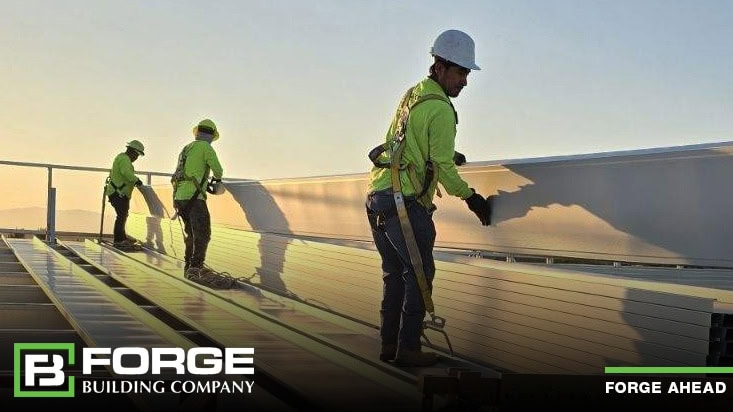
The construction industry is currently navigating a complex and dynamic landscape. Several factors are contributing to its unique state; however, it is still poised for growth. Developers and contractors are working through the challenges, illustrating tenacity and determination to see projects completed. Construction continues to move forward, even when obstacles exist.
The construction industry experienced significant growth in 2023 and 2024. This growth was attributed to a rebound effect from the downward turn during the pandemic. There has been a slowdown in 2025; however, there is still momentum, and several non-residential sectors are poised for growth. Specifically, institutional sectors are projected to have a 6% gain in 2025.
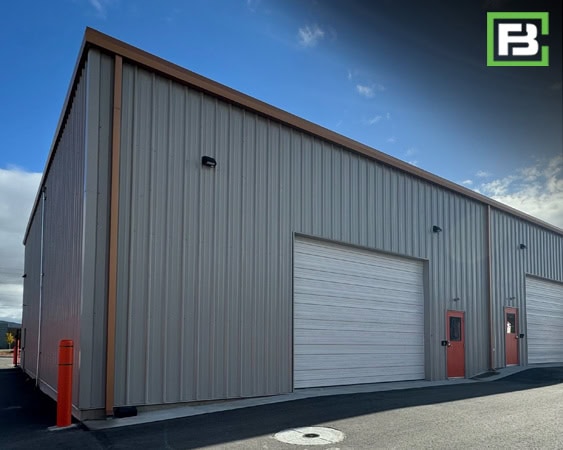 For 2025, the 1 American Institute of Architects (AIA) projects that there will be a modest increase of 2.2% in non-residential construction. This is a slower rate of growth than what has been seen in previous years; however, there was an unprecedented rebound in construction activity post-COVID. 2 The Construction Confidence Index (CCI) for April rose to 61, marking a 6-point increase from the previous month. The CCI is a metric that is used in a survey completed by Associated Builders and Contractors (ABC). When the index is above 50, it indicates optimism amongst the contractors; when it dips below 50, it is a pessimistic outlook. Despite tariff impacts, contractors’ expectations for the next 6 months are optimistic with a strong backlog. The backlog for April rose to 8.7 months, the highest level in 20 months. The southern states have the lengthiest backlog of 10.3 months, which is a good indicator of where the development growth is occurring in the nation.
For 2025, the 1 American Institute of Architects (AIA) projects that there will be a modest increase of 2.2% in non-residential construction. This is a slower rate of growth than what has been seen in previous years; however, there was an unprecedented rebound in construction activity post-COVID. 2 The Construction Confidence Index (CCI) for April rose to 61, marking a 6-point increase from the previous month. The CCI is a metric that is used in a survey completed by Associated Builders and Contractors (ABC). When the index is above 50, it indicates optimism amongst the contractors; when it dips below 50, it is a pessimistic outlook. Despite tariff impacts, contractors’ expectations for the next 6 months are optimistic with a strong backlog. The backlog for April rose to 8.7 months, the highest level in 20 months. The southern states have the lengthiest backlog of 10.3 months, which is a good indicator of where the development growth is occurring in the nation.
With the tariffs and higher interest rates, many investors are in a “wait and see” state, which is creating an excellent advantage for those who don’t want to sit on the fence. While others are waiting and navigating potential risks, it presents opportunities for those who decide to move forward with their projects. This allows for less competition for land purchases and shorter timeframes to get jurisdiction approvals. Also, when less development occurs in specific construction sectors, this creates a space for competitive pricing from contractors eager to keep their backlogs comfortable. Furthermore, many manufacturers hedged against the increased cost of steel with tariffs, purchasing steel coils at a lower cost. With this, it is even more critical to ensure that a project moves forward with this inventory and not the next supply order, which could be at a higher price.
 Beyond the increased cost of materials due to tariffs and the unattractive interest rates, the construction industry also faces a labor shortage. This remains a critical issue for contractors nationwide. 6 ABC’s Chief Economist, Anirban Basu, shares, “While the construction workforce has become younger and more plentiful in recent years, the industry still must attract 439,000 new workers in 2025 to balance demand and supply.” The main factors contributing to the shortage in labor are an aging workforce moving into retirement, immigration policies, and the perception of trades. This labor shortage directly impacts construction projects with schedule delays, increased cost of labor due to low supply, and safety concerns with overworked crews. 7 It is projected that there will be an even greater need for labor in 2026 as interest rates are anticipated to fall, increasing construction development projects.
Beyond the increased cost of materials due to tariffs and the unattractive interest rates, the construction industry also faces a labor shortage. This remains a critical issue for contractors nationwide. 6 ABC’s Chief Economist, Anirban Basu, shares, “While the construction workforce has become younger and more plentiful in recent years, the industry still must attract 439,000 new workers in 2025 to balance demand and supply.” The main factors contributing to the shortage in labor are an aging workforce moving into retirement, immigration policies, and the perception of trades. This labor shortage directly impacts construction projects with schedule delays, increased cost of labor due to low supply, and safety concerns with overworked crews. 7 It is projected that there will be an even greater need for labor in 2026 as interest rates are anticipated to fall, increasing construction development projects.
3 The self storage industry is experiencing a peak in supply, with construction completions forecasted to add 54 million square feet of storage in 2025. For 2026, the new self storage supply is projected to be 20% less than this year. Despite this, several markets are still seeing a continued increase in new or expanding self storage facilities. These trends typically follow the growth trends of people moving or “migrating” to specific markets. With several markets facing an oversupply of self storage, many investors are pivoting to an asset class that is similar, flex space.
4 There is an unprecedented demand for small-bay flex space. The combination of limited supply, increasing demand, and strategic locations makes this segment very attractive to investors and developers. This type of real estate appeals to small and mid-sized companies, such as contractor trades, light manufacturing, automotive services, fitness studios, small retailers, and wholesalers. Small-bay flex units typically range from 1,500 SF to 10,000 SF. The tenants who rent these spaces are not looking for a large commercial warehouse but need space to conduct business.
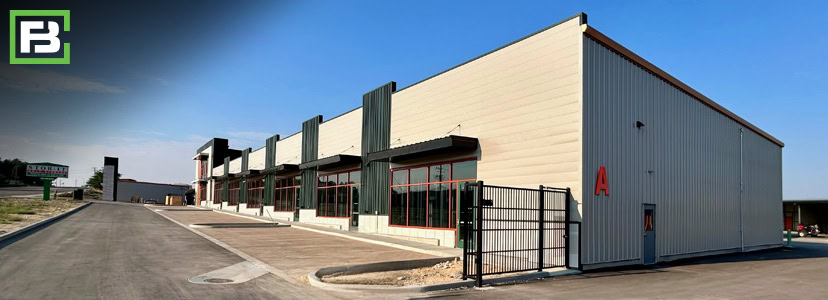
Despite current industry challenges, Forge Building Company is well-positioned to respond with strength and expertise. Its steel building packages for development projects remain competitively priced, supported by a dependable network of skilled installation crews that help mitigate schedule delays. With specialized knowledge in both self storage and flex space, Forge can value-engineer projects to keep development costs in check. While some investors adopt a cautious “wait and see” approach, others are seizing the moment, proving the adage true: When others wait, builders gain.
Contributing Editor: Melissa Anderson, Forge Building Company
References:
1 https://www.aia.org/about-aia/press/softness-construction-spending-predicted-through-2026-consensus-construction
2 https://www.abc.org/News-Media/News-Releases/despite-tariff-impacts-abc-contractors-backlog-and-profit-margin-expectations-improve-in-april
3 https://www.multihousingnews.com/top-emerging-self-storage-markets/
4 https://www.globest.com/2025/04/07/small-bay-industrial-emerges-as-attractive-investment-amid-e-commerce-boom
5 https://personalwarehouse.com/small-bay-industrial-trends-micro-flex-market-booming-2025
6 https://www.abc.org/News-Media/News-Releases/abc-construction-industry-must-attract-439000-workers-in-2025
7 https://www.enr.com/articles/60213-construction-needs-over-439-000-new-workers-in-2025-says-abc
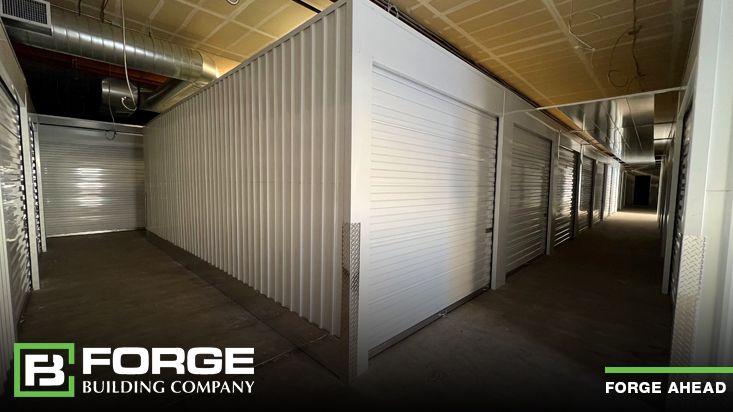
With the recent pandemic and decline in big-box retail, there is now a significant inventory of vacant buildings out there for sale. The current trend of office vacancy rates increasing, building owners are seeking creative ways to make that empty space generate profit again. As such, some are converting these structures into self-storage facilities or selling them to others who wish to do so.
While this development path can be an efficient time and cost-saver, there are important considerations. This blog will help you decide if conversion of an existing building is the right path for you to be able to properly transform a structure into a well-built self storage facility.
Like any building project, there are definitely pros and cons to consider for conversions of existing buildings into a self storage facility. Here’s our take.
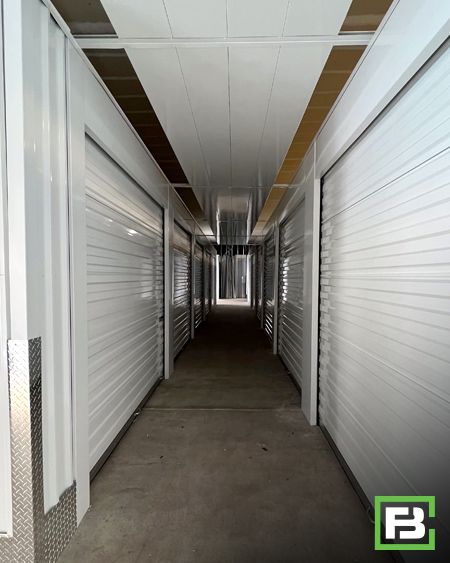 Pros. Because of the amount of inventory out there, you may be able to purchase an existing building for less than it would cost to build it, so after completing the renovation, you’ll have a lower cost basis for your project. Another advantage is that if you maintain the footprint, access points, and site circulation, you may also be able to avoid going through the site-plan approval process with the city, which can save money and simplify entitlements. These advantages add up to an expedited construction schedule at a lower cost.
Pros. Because of the amount of inventory out there, you may be able to purchase an existing building for less than it would cost to build it, so after completing the renovation, you’ll have a lower cost basis for your project. Another advantage is that if you maintain the footprint, access points, and site circulation, you may also be able to avoid going through the site-plan approval process with the city, which can save money and simplify entitlements. These advantages add up to an expedited construction schedule at a lower cost.
Cons. On the flip side, since the structure wasn’t originally built with self storage in mind, it may not always be located in an optimal location for visibility. In addition, the design needs to adapt the building can cause irregular unit sizes and long travel distances from loading areas to units. One other consideration is zoning. This can be a problem since many vacant buildings in commercial zones don’t allow for self storage. Finally, it is important to assess the acquisition price and building condition against all the costs of the conversion and anticipated profits down the road to determine if conversion is the right business strategy.
Along with the pros and cons mentioned above, following are some other considerations.
For any self storage building project, whether it’s a conversion or one being built from the ground up, your site selection is the number one consideration. Retail-like visibility is always preferable to being out of sight. No amount of online marketing can replace the free exposure of being located along a frequently driven, high-traffic route. Proximity to potential customers is key.
One of the most restrictive challenges in pursuing a conversion project is finding a building where self storage is permitted. Thankfully, many jurisdictions appreciate creative solutions to filling empty structures. A zoning authority that has a positive view of storage as a community-serving use will aid your cause; however, if storage is still considered an industrial use that should remain on the periphery of communities, your development path is going to be all uphill, costing excessive time and money.1
As in any type of self storage build, it is critical to understand rates, occupancies, and the competitors around you. The team at Forge always recommends that a complete and thorough market study be completed. It is also key to investigate whether or not self storage is allowed in the zone where the building is located. If it is, then you may need a conditional-use permit or rezoning permit.
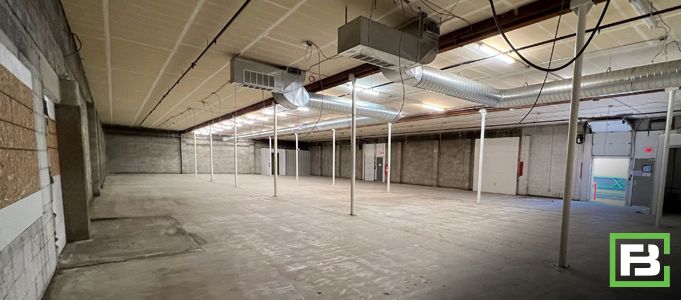
Old Idaho Statesmen Building Before Conversion to Self Storage
Forge also always recommends that you check the title and survey to determine if there are covenants, conditions, and restrictions, easements, and other agreements that could impact your ability to convert the building. It’s common, especially with retail properties, to have private restrictions that prohibit self storage, easements that impact circulation, common-area maintenance fees, shared utilities, etc. Environmental problems are also common, especially in older manufacturing and warehouse facilities. Thoroughly understanding your site and its history is a key part of having a successful project.
When looking at starting a conversion project, typically a commercial zone 2 (C-2) location is the most desirable in a market area. It will typically have a large and destination-bound traffic count and great visibility. In addition, facilities in C-2 typically rent up faster than those in light industrial 1 (I-1).2
It is also good to eliminate any potential site that cannot accommodate a minimum of 50,000 net rentable feet. This is typically optimal for cost-efficient management.
Once you have your site selected, you will need to assess the structure itself – the roof, structure, parking lot, mechanical, etc. In addition, many old buildings have refrigeration systems and other items that are costly to remove. Asbestos, and other hazardous materials remediation may also need to be addressed.
Floor load. If the building you are looking to convert is a multi-story building or has a mezzanine, it is key to ensure the floor load is adequate for self storage use.3 One of the most significant costs in the conversion of office space to self storage will be the assessment and likely remediation of the structural system. Most office buildings have been designed and constructed with a much lower live load than what’s required for self storage, often rated for 50 to 80 pounds load per square foot (PSF) compared to 125. That’s about a 50 percent deficit.
To help you calculate the loading design, it is key to do field measurements with limited destructive testing and a structural engineer. (See our blog titled, “Designing a Self Storage Facility – How to Select Your Design Team”)
If the structural engineer finds that the structure doesn’t meet the required loading for self storage, there are still solutions. Adding light-gauge bearing walls is the most cost-effective, while reinforcing existing beams could also be sufficient. Reinforcing under-bar joists is the costliest solution.
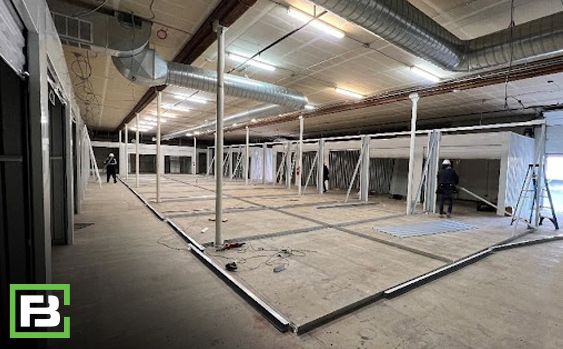
Old Idaho Statesmen Building During Conversion to Self Storage
Rentable Space. Most urban and suburban self storage facilities are 100,000 to 120,000 gross square feet. However, taking into account elevators, stairs, and corridors may reduce the rentable yield to 75,000 to 90,000 square feet. It’s key to know what amount of rentable square footage is necessary to be profitable.
Another consideration you will need to make in this same area of the design, is the average unit size and mix.
In a standard conversion, you’ll use the existing building without changing the overall footprint. This is the easiest, most straightforward type of project. Depending on the building, it is also common to add one or more floors in the existing footprint.
Increasing the rentable square footage of the building through a footprint expansion or the addition of more structures can be another great option. This may include adding drive-up units or vehicle storage in the rear or side of the building.
At the end of the day, the design of your conversion will play a significant role in its success.
Thermal envelope. Energy-code compliance has only been around since 2012. Therefore, the level of renovation necessary will depend on the existing wall, slab, and roof.
Elevators. Check to see if the existing elevators are in your tenant loading/unloading area. A self storage elevator should have a 4,500-pound capacity with a taller cab to accommodate large pieces of furniture.
Loading area. An appropriately sized loading and unloading area with ample space to maneuver large vehicles, such as moving trucks, is key. Your loading area should have a minimal vertical clearance of 14 feet. It should also be convenient to the building interior, particularly the elevator.
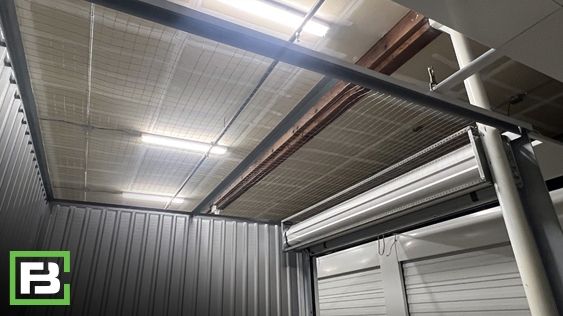
Old Idaho Statesmen Building After Conversion to Self Storage
Self storage has some of the easiest mechanical systems of any real estate type. In the case of an office conversion, the goal is to minimize replacement. The preferred self storage HVAC system is a residential-sized split system with minimal to no ductwork. Boilers and other perimeter unit systems lack efficiency.
A sprinkler system will likely be a code requirement for self storage structures of 100,000 square feet or more. If your building has such a system already, the upgrades should be minimal. The large open areas with no ceilings allow for an optimized sprinkler-head layout.
The last item to evaluate is the electrical system. Typically, the system already in place is likely to be sufficient to meet your self storage needs, but plan to replace the lighting to more energy-efficient LEDs with motion sensors.
The exterior look of the building is key, especially to potential customers driving by. That’s why it is key that your building stands out. Fresh paint, clear, visible signage and nice landscaping increase the curb appeal.
The building-conversion process always comes with extra surprises. Therefore, it’s important to carefully select a professional design and construction team with self storage experience such as Forge Building Company (see our blog titled, “Designing a Self Storage Facility – How to Select Your Design Team”).
Self storage conversions are a great alternative to ground-up development. Evaluating the site, assessing the building, designing the project, and understanding the costs will provide you the information you need to make a wise decision. Finding one that meets the criteria for self storage with limited need for remediation can be a tricky, so working with the team at Forge Building Company can make the process much easier. The budget savings of building a self story facility from a conversion can be 25% to 50%. Give the team at Forge a call today, we would love to help you convert an existing building.
Works Cited
1. Brown, R. (2023, March 22). Inside Self Storage. Retrieved from Insideselfstorage.com: https://www.insideselfstorage.com/conversions/converting-old-office-buildings-outstanding-self-storage-facilities
2. Pollack, L. (2012, July 20). Inside Self Storage. Retrieved from Insideselfstorage.com: https://www.insideselfstorage.com/conversions/retrofitting-building-your-dream-self-storage-facility-guide-intrepid-souls
3. Wyckoff, S. (2021, January 21). Inside Self Storage. Retrieved from Insideselfstorage.com: https://www.insideselfstorage.com/conversions/self-storage-conversion-projects-pros-and-cons-building-assessment-design-pitfalls-and
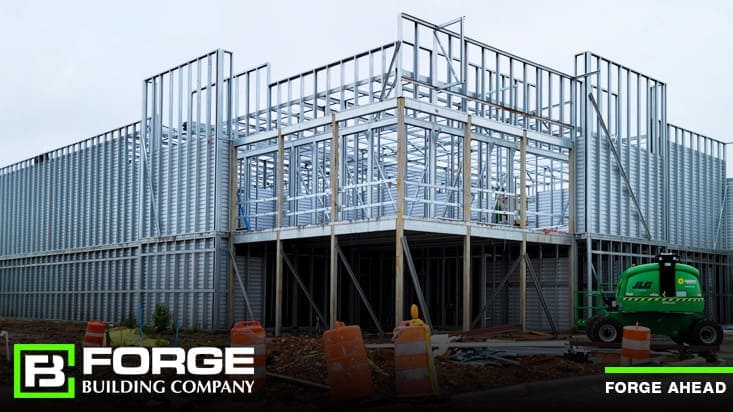
From Alaska to Florida, more than 50,000 self-storage facilities are scattered around the country. That’s about the same number of McDonald’s, Starbucks and Subway locations across the U.S. combined. These facilities are the foundation of the U.S. self-storage industry1, which was projected to generate $37 billion in revenue in 2019. The typical profit margin of a self storage business in the U.S. is 11%.2 That’s well above the profit margins for many other types of small businesses. Given those numbers, starting a self storage business, and keeping your self storage development on track is key. There’s a lot to do and many decisions to make.
Given today’s economy, it is key to act in a timely fashion. Developers and self storage business owners sometimes get stuck in the decision-making process, unable to move forward. No doubt, pursuing a self storage project can be overwhelming since there’s a lot to do and many choices to be made.
By being disciplined and taking one step at a time, you can make smart decisions. Here’s a ten-step plan to keep things moving forward in the right direction.
Before scouting locations for a self storage facility — no matter whether you’re looking at buying an existing facility or building a new one — you’ll need to look at the costs involved. The numbers will vary widely based on factors such as location, acquisition costs, land costs and construction costs. Things you will need to consider include:
Look at the cost of operation. A report released in early 2018 by commercial real estate company CBRE shows real estate taxes accounted for 28 percent of all self storage operating expenses, with on-site and off-site management costs eating up another 38 percent of operating expenses.
Develop a business plan. This can help propel the business toward success, letting you realize your goals and manage issues that might arise. In addition, most lenders will want to see a business plan before extending a loan.
Determine your scale of investment. You might be able to put up a single-story, 40,000-square-foot self storage development in a small town for $1 million or less, whereas a two-story, 80,000-square-foot facility in a more urban setting could set you back $6 million.
You can expect to spend anywhere from $25 to $75 per square foot on new construction. However, the location of the facility — including the cost of the land — will dictate the price tag for construction.
If you’re developing a self storage facility, consider:
Join networking groups and your local self storage association to help you learn from their experiences and gain referrals. Get to know professionals in the legal, real estate, financial, construction, and design industries that are experts in the self storage industry.
 Drive around in the areas that interest you. Look for high-density residential areas and known upcoming residential developments (single- or multi-family).
Drive around in the areas that interest you. Look for high-density residential areas and known upcoming residential developments (single- or multi-family).
Contact a commercial broker and/or your municipality. The city may be selling multiple parcels it owns. Based on its size, think critically about what type of facility could be built on the parcel.
Estimate whether it's good for self-storage. Call the municipality to find out how the land is zoned and any relevant regulations regarding industry development. If the property is already zoned for self storage, that removes a huge barrier. But if the property needs to be rezoned, you could spend months or years seeking approval for a zoning change.
Additionally, the issue of entitlement involves obtaining approval from government entities for your development plans. As with rezoning, an entitlement case could elapse valuable time.
Purchase the land with a 120-day due diligence period. The contract should state that your deposit is refundable during this period if you decide to forego the purchase. If you choose to buy the land, your deposit becomes non-refundable at 60 days. Also, give yourself 180 days to close.3
Complete a market feasibility study. This exercise will help you target the demographics of the customer base within a one- to five-mile radius of the facility. A three- to five-mile area is the typical size of a market for a self storage facility.
You’ll want to validate the median income in the market area (self storage renters tend to be in the middle-income and upper-middle-income brackets), along with the median age (self storage tenants are normally in their early 20s to mid-50s).
In addition, you’ll want to review the following aspects of your proposed market area4:
Other components of the feasibility study normally will include an overview of the self storage industry; long-range projections for rental rates, income, expenses, and property value; and details about the storage project’s zoning. This will help you determine whether the investment's land acquisition and building costs are sound.
This is also the time to look for any obstacles, such as easements, building restrictions, zoning and entitlement hurdles, water retention requirements, and wildlife, tree, or waterway conservation restrictions.
The study should also help determine your unit mix, what phases to build, and the amenities you should offer to achieve your desired return. It provides your operational budget, lease-up period, financial projections, and marketing plan and feeds into the basis of your business plan.
Determining how to finance an acquisition or a new development is your next step. Do you need to take out a loan? A number of options are available, such as acquisition loans, construction loans, and SBA loans. Many of these loans cover terms of 10 to 25 years. Work with a lending professional who’s well-versed in the self storage industry to point you in the right direction.
To qualify for a self storage loan, here are four things you’ll likely need:
Make sure you have enough liquid capital not only to buy or build a facility but also to operate the facility.
You may also want to consider strategically partnering with other investors to buy or build a facility. This can be done through:
If going the loan route, contacting multiple self-storage lenders and negotiating the best terms is best.
Be ready to send each lender or investor all the documents they need to make a quick decision. Your packet should include everything from your feasibility study as well as the items mentioned above, along with your business plan, tax returns, and personal financial statement.
If you ultimately choose a Small Business Administration loan, allow 90 days to close. If you’re going with conventional financing, allow 60 days.
At this stage, there are things you must do to prepare for building – obtain various reports and geographical surveys, such as a phase-one environmental site report, a soil-borings report, an engineer’s preliminary report, and an endangered-species report. Developing a self storage facility requires expertise so organizing your design team is crucial. The team at Forge can lead you through this process.5
A development team should include experienced legal, real estate, financial, construction and design professionals. Few people who are new to the self storage industry can solely develop a new facility.
The design process starts with a survey of the land. The architect creates a plot plan indicating the locations of buildings in relation to the land. In this initial design, the architect considers all the information the civil engineer has provided about site restrictions and the availability of utilities.
The next step is to design the floor plans followed by the elevations, or what the building will look like. Cross sections and details are added to indicate floor levels and details of footings, foundation, walls, floors, ceilings, and roof construction.
The structural engineer then assures the materials and how they are assembled are strong enough to withstand their weight, the weight of any use it may be put to, and all internal and external forces—known as vertical loads and lateral stresses—applied to the building.
A load is any force exerted upon a structure such as snow, wind, or earthquakes or the weight of the building itself. Live loads are produced by people, furnishings, equipment, and materials inside the building. Stresses are internal forces of a material constructed to resist external forces.
The civil engineering plan provides information about the excavation and grading needs the subcontractor will require to prepare the soil for foundations, ensure stormwater drains from the site, determine contours and elevations, and provide an earthwork estimate. That data will also help them provide an accurate bid for crew size, equipment, and timeline, and it’s needed by the retaining wall subcontractor and building manufacturer.
Forge Building Company has created its building design that allows for efficient use of materials and allows for crews to build quickly.
 Once the team has been assembled, the general contractor is responsible for making sure that everyone is building the project in accordance with the design. General contractors may provide labor and materials themselves, use subcontractors and vendors, or a combination of the above. Subcontractors provide their own shop drawings and may be in charge of trade-specific permits and inspections.
Once the team has been assembled, the general contractor is responsible for making sure that everyone is building the project in accordance with the design. General contractors may provide labor and materials themselves, use subcontractors and vendors, or a combination of the above. Subcontractors provide their own shop drawings and may be in charge of trade-specific permits and inspections.
The general contractor weaves everyone’s efforts into the completed product. Because of the volatility of material markets, most contractors won’t lock in pricing for materials and there could be price increases when material orders are processed. It is a good idea to ensure you include a Price Increase Contingency amount in your budget.
When you reach this step, the team at Forge is ready to assist. We will ensure your self storage project is built on schedule and on budget and will take pictures along the way.
With a project start date determined, your general contractor will give you expert feedback on construction activity and sequence of work to accomplish your goals best. Along this path, milestones will be identified such as:6
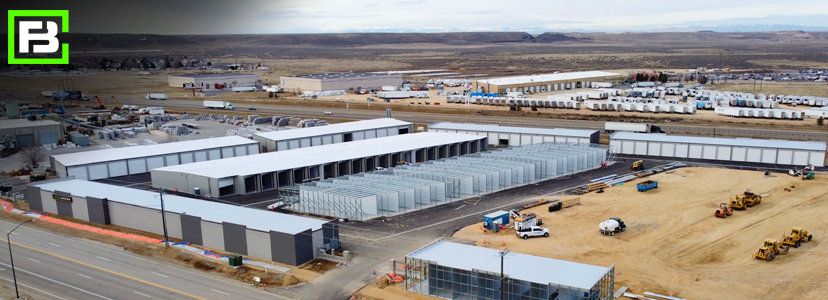
As the schedule is designed, the general contractor typically gets requirements from the major subcontractors to help determine realistic timelines. This information can also help identify long lead times for materials so they can be addressed early in the purchasing process and reviewed for the projected construction cash flow.
This is also a great time to set up your property-management systems and marketing initiatives to be ready to open as soon as you receive your Certificate of Occupancy. For technology considerations, see our blog “Technology – What You Need for Your Self Storage Business.”
Now is the time to leverage your marketing to lease the facility storage units. Your website is one of the biggest assets for a positive customer experience. It should be easy to find and use.
Content for your web presence is the single most important thing for search engine optimization and for prospects and customers to be able to find your business quickly. This includes your blog posts, social media, landing pages, FAQ pages, videos, and everything else related to your business.
Other helpful technology that will improve the customer experience includes any automation you use, security and access tools, digital signage, and property-management software that facilitates online rentals and autopay. Customers expect technology that’s easy to use, available around the clock, nice to look at, and engaging.
For more tips on creating the best customer experience, see our blog “Creating the Best Customer Experience for Your Self Storage Business.”
Once your self storage development is built, open, and renting, the most important aspects of hitting or exceeding your projections and maintaining high performance are answering your phone, monitoring rates regularly, keeping customers happy, and monitoring your marketing and online presence. In addition, it is key to think about giving back to your community, rewarding your employees, and starting to look for land for your next facility!
One of the best ways to create the ultimate customer experience is to walk through the process of renting a unit, visiting the site, and accessing the unit. Was anything surprising? Confusing? Alarming? Go about this drill as if you’re someone who knows nothing about the industry and see how easy it is to navigate the process of looking for, renting, and using self-storage.
The relationship you build with customers through these strategies and how you fulfill their needs is ultimately what will make their experience pleasant and help with retention and referrals in the future.
Works Cited
1 SpareFoot. (2021, January 27). Retrieved from SpareFoot StorageBeat: https://www.sparefoot.com/self-storage/news/1432-self-storage-industry-statistics/
2 Egan, J. (2021, September 13). Storable. Retrieved from Storable: https://www.storable.com/resources/learn/is-a-self-storage-business-profitable/
3 D’Agostino, K. (2021, October 5). InsideSelfStorage.com. Retrieved from Inside Self-Storage: https://www.insideselfstorage.com/development/9-step-plan-keep-your-next-self-storage-development-track
4 Egan, J. (2021, July 26). Storable. Retrieved from Storable: https://www.storable.com/resources/learn/starting-a-self-storage-business/
5 Inside Self Storage. (2008, September 15). Retrieved from InsideSelfStorage.com: https://www.insideselfstorage.com/construction/building-self-storage-creating-harmonious-design-team
6 Rogers, R. (2016, October 6). Inside Self Storage. Retrieved from InsideSelfStorage.com: https://www.insideselfstorage.com/construction/creating-and-managing-self-storage-construction-timeline

Self Storage Construction Costs are on the rise in this current economy, but the factors that impact a project go far beyond the price of steel and other material costs. This blog addresses variables emerging out of the current climate, hidden expenses to watch for, bidding pitfalls and ways to mitigate overall self-storage development expenses.
Self-storage construction costs are based on many different variables and fluctuate from location to location. The one consistent thing is they’re on the rise. If you’re planning to build a project this year, it’s more important than ever to be on target with your research, design plans and bids. You must adjust to the market conditions and execute the development process correctly.
Partnering with a steel building contractor, such as Forge Building Company, can be the difference in a successful build that stays on budget and one that can spiral out of control. As the developer or owner, you should be a big part of the day-to-day planning, coordination, and execution.
Here’s what is happening with self storage construction costs today and some important considerations that can impact these costs significantly.
A recent article from Inside Self-Storage, states that in a short amount of time the cost of single-story construction jumped from $65 to $85 per square foot. This essentially means that with a $6 million, phase-one budget from the Small Business Administration, you’ll likely build closer to 40,000 square feet than 50,000. Your alternative is to increase your development budget by $600,000 to build closer to your original goal.
Yearly price increases are very typical in self-storage construction. Although it may be frustrating while you’re building, it can deter would-be competitors once you open a facility. Additionally, you may hear every spring that the price of steel is going up. The COVID pandemic has reduced steel manufacturing and typical stockpiling. This, along with crippled supply chains, has caused prices to double.
Though some folks may advise you to hold off on building self-storage until steel prices come down, this could take months or years, or may never happen. An indefinite pause can quickly turn into a back-to-zero strategy in which you may never build.
Building manufacturers are starting to report a leveling off of price increases. Of course, it’s impossible to predict where prices will end up or how long it’ll take to get there. Still, steel production appears to be on the rebound, and demand will increase once the auto-chip deficit is over, and more cars are built. More will also be required when commercial development picks up across construction sectors beyond self-storage.
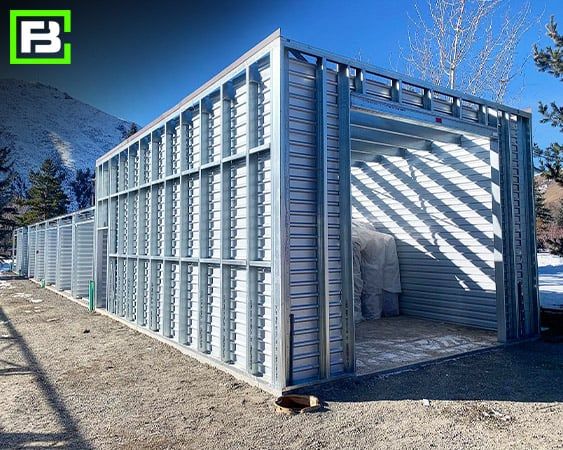 Self Storage Builders cost is only part of your total development costs. There are many ways to reduce costs and avoid overruns, and it all begins by properly reviewing a potential self-storage property in detail and making accurate assessments when it comes to site work before determining an offer price. It is key to find a site for the right price! Research the right zoning, and the right demographics to support your business. (Egan, 2021)
Self Storage Builders cost is only part of your total development costs. There are many ways to reduce costs and avoid overruns, and it all begins by properly reviewing a potential self-storage property in detail and making accurate assessments when it comes to site work before determining an offer price. It is key to find a site for the right price! Research the right zoning, and the right demographics to support your business. (Egan, 2021)
For example, land may drive up self storage construction costs by $100,000 to $400,000 or more due to bad soils, steep topography, unusable land, and other issues. Existing utilities or their absence are always a factor, too. In many states, you must build an unreasonable number of costly firewalls if there's no water service. Sometimes, even if there’s suitable water, it may be on the other side of a major road. In that case, it may cost an extra $50,000 to bore under the road to make it work.
So, while the location is the first of many assessments you need to make, you’ll also need a civil engineer to review properties and local regulations. Extra costs may be expected with one site versus another. In addition, some municipalities have severe building coverage limits and other regulations that can impact a project. This can result in an extra cost of several hundred thousand dollars. For other considerations, see our blog titled “Contractors That Build Commercial Storage Buildings & Facilities”.
To maximize your savings and optimize the cost of self-storage construction, it’s important to keep all of this in mind when negotiating land costs. Not fully understanding the expenses tied to certain building and site-design features can lead to incremental extra dollars per square foot. According to Inside Self-Storage, below are several other items that can impact your overall project cost.
Finally, pay attention to storm-drainage costs, which are dependent on many items, including roof directional pitch, building gutters, curbing and sheet flow to drainage swales, when possible. The difference between a well-thought-out drainage design and a typical, off-the-shelf solution can be $100,000 or a few dollars per square foot.
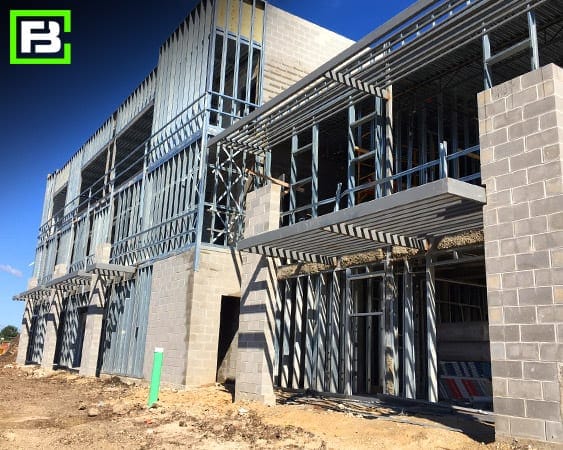 Poor project bidding specifications can lead to higher self storage construction costs. So it is key that the plans and specs are dialed in and very specific to avoid cost overruns.
Poor project bidding specifications can lead to higher self storage construction costs. So it is key that the plans and specs are dialed in and very specific to avoid cost overruns.
Every construction contract should have an addendum to list items that might otherwise be overlooked or that aren’t in the bid. (Goodin, 2019) These include:
Also, if there are specific brand or quality requirements, these should be stated in the addendum with a note that no substitutions are permitted. The cost and quality of various types of fencing, gates, security systems, kiosks, desks/cabinets, cameras, metal buildings, etc., can be significant. A bid addendum helps ensure all parties are on the same page.
Keep in mind, too, that contractor budget allowances may be low. Items like security, signage and office desks/counters should be detailed prior to bidding to obtain a fixed fee or more realistic budget. Here are some additional items you should account for in the total cost of self-storage construction and financing:
Incomplete bids are dangerous and lead to higher prices and unexpected cost overruns. This is particularly important because with higher self storage construction costs, your contingency budget may have less money to deal with overruns.
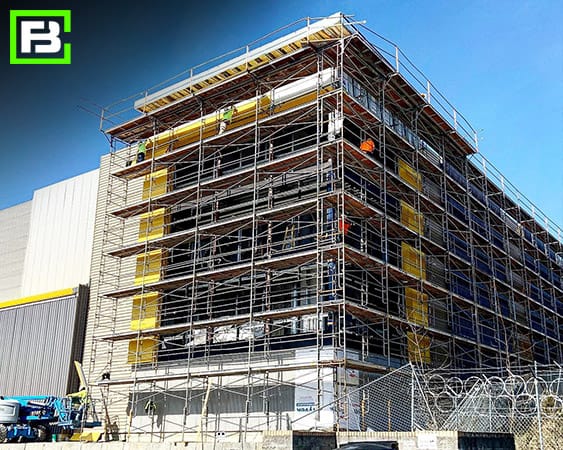 Part of the project-planning process is to understand what kind of self-storage operation you’ll be running. Your lease-up plan must be written and detailed long before you begin designing or a quick path to breakeven most likely won’t occur. It should include your sales and marketing efforts as well.
Part of the project-planning process is to understand what kind of self-storage operation you’ll be running. Your lease-up plan must be written and detailed long before you begin designing or a quick path to breakeven most likely won’t occur. It should include your sales and marketing efforts as well.
The good news is national self-storage occupancy figures have risen from approximately 88% (Onedesk, 2021) to 94% in the last year, driven by:
This gives you greater facility value and the ability to recuperate project expenditures. One of the greatest benefits of real estate is that it appreciates. Self-storage owners also receive benefits from depreciation and amortization. The greatest thing is that once you build, you can typically raise rental rates each year to accommodate increases in expenses and generate more profit. And when it comes time to sell, you’ll have an asset that’s worth more than when you purchased or built it.
2021 was a record year for the number of self-storage facilities sold. Higher occupancy and record rental rates have laid the groundwork for increases in profit. The current market trends still show clearly that building is typically cheaper and more profitable than buying.
There are a lot of factors impacting self-storage construction costs. Working together a knowledgeable development team before you make an offer on land and properly executing each step, from due diligence to bidding to design to operation, is necessary to keep everything moving in the right direction. For other keys in selecting a commercial steel building contractor, see our blog titled “Commercial Steel Building Developers.”
These are just a few of the qualities that make custom steel buildings the right choice for business use cases. When you are ready to learn how a metal building can help you achieve your goals the team at Forge Building Company is ready to serve you. Give us a call to discuss your project. You are the glue that’ll hold everything together.
To view our pre-engineered steel buildings, see https://forgebuildings.com/projects/.
Sources: